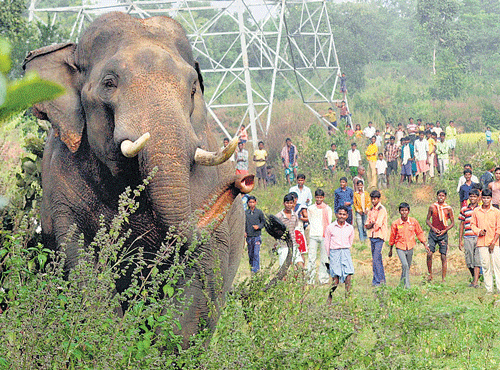
When elephants go wild, what solutions do we have? Do we keep them in captivity at an extra cost or do we release them back into the wild only to be a witness to elephant rampage again, asks Ganashree Kedlaya
And so they stand, sombre and resigned, with limited foraging movement in an unnatural environment, looking forward to a disagreeable future. Operation Malai saw the capture of six wild elephants in Jawadu Hills of Tiruvannamalai and Vellore districts following a court order passed on August 19, 2013, to be held captive in the Mudhumalai and Anamalai Tiger Reserves.
This was soon followed by a notice to the Centre and the Tamil Nadu Government by the Madras High Court based on a PIL challenging permanent confinement of the elephants, and hence requesting its release.
So, where are these six elephants today? We were fed good amount of news on conflicts, crop raids followed by capture of these six elephants – but what about its current status?
Closer home, the Karnataka Government has approved the capture (to permanently hold captive) 25 wild elephants from Hassan-Alur regions. When human-elephant conflicts continue to escalate due to anthropogenic reasons, how many ‘wild’ elephants can we hold captive? Or should any be held captive at all?
Missing matriarch
And so it goes, explains Surendra Varma, a research scientist with Asian Nature Conservation Foundation (ANCF), who has been a part of the review committee on the issue, “The six elephants originally belonged to a larger family that migrated in the 1980s from Bannerghatta National Park to Andhra Pradesh. Chief Minister, N T Rama Rao, revering elephants to Lord Ganesha hosted the herd and declared the area a sanctuary (Venkateshwara).”
There were no elephants in Andhra prior to this, and hence little scientific understanding of the species. This cost the herd dearly, as many elephants died due to starvation. Human-elephant interactions in the area intensified, forcing a few back to its home range.
“But many smaller groups moved into other forest areas like Palamenar, Tirupattur and Javadu Hills. The herd of eight elephants eventually became six, after an adult bull moved out and the matriarch died,” recounts Varma. This infamous herd (3 sub-adult males and 3 females) without the matriarch displayed unpredictable behaviour.
From the year 1999-2012, there have been over 11 human deaths, crop raids were common and protests from locals slowly grew. The Tamil Nadu Government demanded a review of the situation and an expert committee was formed.
The decision
The government of Tamil Nadu sought approval of the Ministry of Forest and Environment (MoEF) for translocation of the herd to Sathyamangalam, which required consent of local communities.
“But the locals did not agree. Also, relocating them to nearby forests wouldn’t stop them from returning to the same village. This herd was completely isolated and hence understanding of social organisation and hierarchies were poor,” explains Varma. These elephants lived many years away from forested areas, hence habituated to raiding crops and easy access to food.
Habitat degradation also made migration quite impossible, especially after the construction of the four-lane national highway (Bangalore-Chennai) in 2002. With less access to food and water, this herd was inevitably confined to human-dominated landscapes.
“With only one adult male, threat of inbreeding could not be ruled out, which is not good for the herd genetically. We have been studying the conflict situation in Tamil Nadu for many years. I would never suggest captivity but this case has been different for all reasons mentioned above,” explains Varma.
What next?
But things didn’t proceed as promised by the Forest Department. Contrary to what was assured, the elephants were separated and held captive in kraals in two tiger reserves, with no proper facilities and training to ensure a safe and less stressful environment.
Explains M Santhanaraman, Advocate, High Court, Madras, who is currently handling the case, “A PIL has been filed demanding release of these elephants. But unfortunately, it’s not advisable to release them into the wild again as they are domesticated and have been living in captivity for over six months now. This will only lead to more conflicts in the future.” As the decision of release has been passed, the court awaits response from the Chief Wildlife Warden, Tamil Nadu without whose approval, no action can be advanced.
Probable suggestions
“One option would be to translocate these elephants to the Moyar Valley, where villages are not within forest limits and provides access to the Eastern and Western Ghats, allowing elephants to migrate to better habitats. Besides captivity being a deviant solution, it’s also not practical. Keeping wild elephants in captivity will cost the government crores of rupees,” he adds.
Many captive elephants die in India each year, clearly emphasising lack of infrastructure, fewer skilled personnel fit to train wild elephants and ill-informed systems in power.
Operation Malai could be an unusual case, but lack of transparency post capture by the Forest Department sheds light on how they are not yet equipped for such a situation. “Are all mitigation methods followed, can these animals be translocated, what level of welfare is being sacrificed, is it scientifically passable to separate a herd from a breeding female? There are many critical criteria to be considered, and personally, I feel, capturing a wild animal to be held captive should be the last option,” emphasises Varma.
In the midst of PILs and court orders, the fates of these six wild elephants remain permanently changed – never for the better!